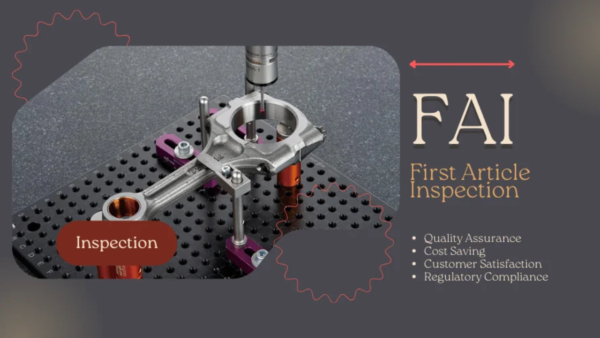A Comprehensive Guide to First Article Inspection (FAI): Key Steps, Benefits, and Tools
When it comes to timely deliveries no one can deny its importance. Lacking the qualitative checks may lead you to face costlier mistakes, no customer satisfaction, and delays. These problems may lead you to experience reworking, no standards compliance, and risking safety. This is true specially in higher regulation industries. When your products does not fit to the required specs, it eventually damage your reputation.

Don’t worry FAI help you avoid it. Windering “what is fai first article inspection?”. It is nothing but a comprehensive report on if your first produced products comply with deign and qualitative standards. This report ensures each of your product features strict follow up opf regulatory requirements and are defects free. Multiple series of industries including electrical, automotive, aerospace, etc. rely heavily on FAI for quality and consistency. Keep reading this article to uncover facts on FAI process, perks, elements, challenges, and more. Let’s get started!
The FAI Process – Stepwise Guide
Table of Contents
TogglePrior First Article Inspection (FAI), require you to conduct the ground working. At first review the specs of products along with drawings. It entails that you have better understanding of the requirements of the design. Later you need to setup the the materials suppliers for your products. Prior to sourcing ensure that each of your product materials align with the specific standards. Set up clear material acceptance rules or terms to define effective FAI.

Step 1: Initial Documentation/Inspection
Carry out the inspection of the materials and specs of the product. Carry out the effective inspection of the product regarding tolerances, dimensions, and materials. Record the results in a document for any tolerance deviations and wrong manufacturing materials for the product. All this type of inforamtion serve as the basis for the First Article Inspection (FAI) Report. This document contains all such information regarding inspections and ensure follow up of specifications of the production.
Step 2: Validation and Verification
After finishing the initial level inspection, now comes the results validation and verification. Find out the final product measurements, dimensions and check it against the initial measures present in the report. At this step it is vital to ensure that your manufacturing process completely align with the intention for design. In case you come across any kind of discrepancies as well as variations, then find out the root cause and implement corrections. This step will help you avoid errors and ensure consistent quality through multiple product batches.
Step 3: Results Submission
When the validation finishes up, forward the reports to the regulation bodies, or stakeholders, etc. Before submitting make sure that each element of the report is accurate and right. You can do so by reviewing. In case you find any non conforment issues then make changes appropriately. The main role of this step is to bring everyone on the board bby representing the current status of the product.
Step 4: Consistent and Continuous Improvements
Whenyou have submitted the report do not think that the process ends up here. You need to take the feed back regarding the product and make changes accordingly. It may be the product specs or be the manufacturing technique. Improvement is something that is continuous, from this the manufacturing as well as quality of the product take benefit and improves efficiency.
Key Elements of FAI
1. Verification of Materials
FAI starts at ensuring that all the materials used in the process are as they should be. It is to make sure that the materials are in proper condition and as stated in the CoS. It is recommended to ensure that the materials are obtained from reliable suppliers and this is done by checking the Certificates of Compliance (CoCs) for the supplier. This helps you avoid problems that may occur in the future and give you the guarantee that the products you are manufacturing will have a long life span.
2. Dimension Inspections
The accuracy is usually established by tools such as Coordinate Measuring Machines (CMMs) and micrometers. The dimensional checks can be done in order to ensure that the product is manufactured to the right size and shape so that there is no wastage in production and no further work is needed.

3. Operational Testing
In applications where the effects of failure may lead to safety concerns or product recalls functional testing is essential. These tests assist you in ascertaining that your product works as planned and designed when subjected to actual usage conditions during the FAI process.
4. Visual Inspections
You can examine the quality of the product visually. This way you can point out any defects, appearance, and finishing. A falwless product is the key when it comes to the statisfied customers. This way you can ensure or fulfill customer desires through precision based and defect free products.
5. Assembly
The assembly step determines the fitment of the product as per the initial design. It involves In this step you check for the ideal assembly or isolation of the parts. Proper fitting ensure secure and safe operation of the product through its life. Apart it also confirms the safe mass production of that product. You can streamline process this way.
6. Standard Compliance Check
In the end you need to make sure that each of the product strictly align with the industrial standards. This level of checking makes sure that every product that you product meet the standards including ISO, FDA and so on. In medical as well as other industries like aerospace this check is highly crucial and important.
Equipments and Tools Used for FAI
Various tools and equipment are utilized during FAI first article inspection to meet the requirements of accurate measurements and quality standards. Here’s an overview of the key tools involved:
Measurement Tools
You will use the calipers, micrometers, and coordinate measuring machines (CMM) to measure components precisely. These are tools that will allow you to measure to micron level precision. Beyond this, laser scanners and 3D measurement tools offer more advanced capabilities that let you capture complex geometries and ensure accurate, design-ready parts.
Testing Tools
Stress testers, tensile testers, and performance testing devices will be used for testing materials strength and performance. Visual inspection is equally important. Magnification systems and good lighting arrangements aid in detecting surface defects, cracks, and similar imperfections that are not easily perceived with the naked eye.

FAI Documentation and Software Tools
For documentation and compliance, FAI reports are a must. These reports are created, maintained, and analyzed through software platforms. You’ll also need to ensure accuracy and consistency throughout the process having document control systems to track report versions and approval workflow.
Data Acquisition System
Making informed decisions require real time data collection. IoT sensors are integrated into data acquisition systems that automatically collect data during the inspection process. It allows you to get accurate data so your FAI reporting is accurate and this helps in future decision making.
Non Destructive Testing Tools
The term non destructive testing represents the tools like x-ray machines, eddy testers, ultrasonic machines, etc. For high risk industries these tools are imperative. Specially where you cannot ignore the reliability or safety.
Benefits of First Article Inspection
First Article Inspection (FAI) offers significant benefits of streamlined manufacturing process and improved product quality.
Ensures Product Conformance
It is guaranteed that the first product meets design specifications. First, you can look at the first piece to see if it matches up with your design intent. This step prevents errors from propagating into subsequent production runs, and ensures consistent quality based on standards.
Risk Mitigation
This helps FAI identify manufacturing or design flaws early. Early detection of these issues reduces the likelihood that product recalls, rework, or defects will occur, which can be extremely costly. Preventing operational disruptions and customers’ dissatisfaction is through a proactive approach.

Enhances Collaboration and Communication.
It makes for better communication between you, your suppliers, and your manufacturers. It helps with the baseline of the environment, just making sure everyone is on the same page from the offset. This collaboration helps build trust and ensure the project goes in the right path, little misunderstanding and error.
Regulatory Compliance
This is particularly true for industries that have very strict regulatory requirements. This ensures your products pass all industry standards and certifications necessary to complete the auditors and inspections. This becomes critical in sectors such as automotive, aerospace and medical devices where non compliance can result in being liable to penalties or delays.
Cost-Effectiveness
Issues are noted early before the fabrication process is complete to save time and money. It saves the client money by avoiding rework, delay in production, or the risk of missing deadlines. It prevents flaws from running out of control; improving overall efficiency, decreasing waste and increasing profitability.
First Article Inspection Challenges
Time and Resource Intensive:
The FAI process can be resource and time intensive, especially for complex products. It takes a lot of manpower to thoroughly inspect and test each component. But in fast paced industries where speed matters FAI might be too thorough. Production timeline has to be delayed if inspections are contained too long, rushed inspections may not release overlooked issues.
Accuracy and Precision:
FAI measures and tests must be very accurate and precise. Even a very small deviation from the plan can still result in a failure. The results depend on the variations in the testing equipment, tools or skilled operator. It is crucial to keep measurement processes consistent and train operators for reliable results.
Cost of Prototyping and Testing:
The first article is the most expensive and requires more prototyping and testing materials in most cases. Managing these expense can be difficult without compromising on the quality of the product. You want thorough testing but have to balance to keep costs down. This is a key challenge to keep the bottom line healthy.
Supplier Issues:
Supplier delays or failure to meet/satisfy specifications can derail the FAI process. Late or subpar materials can cause delays that can lead to disruptions the entire timeline. Since we need the materials according to the standard quality of them, it is very important that we have a strong relationship with our suppliers so that we receive them on time. This is especially helpful in minimizing disruptions, and keeping your FAI process going as planned.
How to avoid common mistakes in the first article inspection
Inadequate Documentation:
Documenting every step in your process will help prevent confusion and costly mistakes like First Article Inspection (FAI). It is not easy to manage decisions, changes or findings without proper records. Always make sure you document the complete inspection including precise measurements, material, and any issues found. Standardized forms and templates that and capture all necessary information and easily accessible for future reference.
Overlooking Tolerances:
Ignoring or misunderstanding critical tolerances is a common mistake. They can ride or get misused. Thorough review & verification should be conducted on critical dimensions in the design. So take those measurements with the FAI and compare them against a worked tolerance. Pay attention for the upper and lower limits of tolerance to avoid producing parts that will fail once assembled or field use.
Incomplete Functional Testing:
An egregious oversight is failing to invest in and run functional tests or, at least, to run them under unrealistic conditions. Functionality testing ensures that the product is actually doing what it should in reality. Make all tests that have to be done under the conditions where the product will be used. For example, such tests could include temperature, pressure or load. If not, flaws will go undetected that can detrimentally affect product performance or safety.
Rushing the Process:
If there are deadlines, you can race through the FAI process to get there fast enough to miss out on some of the details and overlook some of the quality issues. Each and every step must be a thorough, exact step and FAI should not be rushed. Ensure that the teams appropriately allocate time to the process and ensure that they are as precise as possible. Planning and patience are the keys to preventing all the problems from occurring and get through all the problems before mass production begins.
Industry Specific Considerations for First Article Inspection (FAI) Checklist
Aerospace:
In aerospace and in regulatory compliance, precision is critical, which is why FAI is essential. There are strict standards you have to follow from organisations like the FAA or EASA. The parts parts you manufacture often have safety critical functionality and accuracy is crucial! Verifying performance under extreme conditions may require additional certifications and specialized testing, like thermal or stress.
Automotive:
In the automotive industry, FAI is critical to lots of aspects and functional testing to ensure that parts fit and work how they are supposed to. IATF has confirmed that FIA would have to comply with industrial standards such as ISO 9001 and IATF 16949. These certifications ensure that a uniform high quality, reliability and constant improvement in production is ensured. This early testing will detect any issues early, so they can be fixed early, reducing the likelihood of defects in the final product.
Medical Devices:
In ensuring that medical devices meet the FDA regulations and the ISO 13485 standards, FAI takes the role to train and validate medical device validation systems and software. This test should be concentrated on risk management, traceability and sterilization tests, so that patients are kept safe. Then, you need to make sure each device is working and is not contaminated. Proper documentation and thorough inspections are required for compliance and quality control.
Electronics and Consumer Goods:
In electronics and consumer goods, performance, reliability and safety are key. FAI also confirms that the products have CE, UL or RoHS compliance etc. These certifications make sure that your products are safe to use, environmentally friendly and of high quality. This helps standardize testing of electrical and functional performance, lowering the likelihood of recalls and defects.
Successful First Article Inspection – Best Practices
Centralized Specifications and Design Intent
You have to make sure that your FAI report has documented all the manufacturing specs clearly. The specifications are so clear that different parties involved will get the needed things. Confirm and double check the specs with every designer, supplier and engineer onboard to avoid confusion and a wrong manufacturing. In doing so, you may avoid error and conduct inspections accurately.
Comprehensive Training Inspectors
Proper tools and knowledge are needed to be given to the person who should be able to conduct and document the FAI. It is crucial to maintain up to date on mdern technics and also successful and structured training of the inspectors. Ultimately, this will be to your benefit and enable you to have high end accuracy and effectiveness.
Automation and Technology Use
Make use of modern and even up to date technology for toolings that aids successive FAI report. Use CMM to obtain the coordinates exactly according to your needs. Make using AI powered systems convenient and accessible further. This will help in efficiency of operations.
Set a Clear Approval Workflow
Do not hinder the approval process of the FAI report. Make sure that before you start with the working, all parties have signed the report and examined it thoroughly. This will together take everyone on the same page and will help you have an organized process flow.
Conclusion
Acting upon First Article Inspection (FAI) put you on edge in market for qualitative and consistent production. Besides it ensure that every single product from your side strictly meets the cope up with rigorous standards. FAI not only improves your production process but it also improves your market reputability and customer conversion rates. Utilizing the FAI as a strategic tool you can keep on fostering your efficiency and effectiveness.
